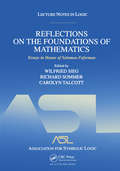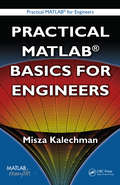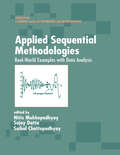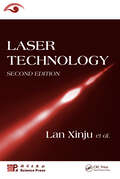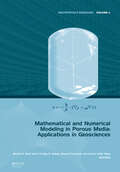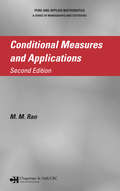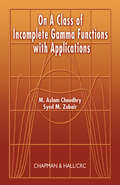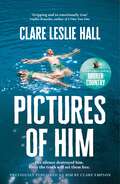- Table View
- List View
Reflections on the Foundations of Mathematics: Lecture Notes in Logic 15
by Carolyn Talcott Wilfried Sieg Richard SommerSolomon Feferman has shaped the field of foundational research for nearly half a century. These papers, most of which were presented at the symposium honoring him at his 70th birthday, reflect his broad interests as well as his approach to foundational research, which places the solution of mathematical and philosophical problems at the top of his
Chemical Reactor Design
by Peter HarriottFeaturing case studies and worked examples that illustrate key concepts in the text, this book contains guidelines for scaleup of laboratory and pilot plant results, methods to derive the correct reaction order, activation energy, or kinetic model from laboratory tests, and theories, correlations, and practical examples for 2- and 3-phase reaction
Practical MATLAB Basics for Engineers (Practical Matlab for Engineers)
by Misza KalechmanA comprehensive and accessible primer, this tutorial immerses engineers and engineering students in the essential technical skills that will allow them to put Matlab® to immediate use. The book covers concepts such as: functions, algebra, geometry, arrays, vectors, matrices, trigonometry, graphs, pre-calculus and calculus. It then delves into the Matlab language, covering syntax rules, notation, operations, computational programming, and general problem solving in the areas of applied mathematics and general physics. This knowledge can be used to explore the basic applications that are detailed in Misza Kalechman’s companion volume, Practical Matlab Applications for Engineers (cat no. 47760). .
Introduction to Numerical Programming: A Practical Guide for Scientists and Engineers Using Python and C/C++ (Series in Computational Physics)
by Titus A. BeuMakes Numerical Programming More Accessible to a Wider AudienceBearing in mind the evolution of modern programming, most specifically emergent programming languages that reflect modern practice, Numerical Programming: A Practical Guide for Scientists and Engineers Using Python and C/C++ utilizes the author's many years of practical research and tea
Fourier Series in Several Variables with Applications to Partial Differential Equations
by Victor ShapiroDiscussing many results and studies from the literature, this work illustrates the value of Fourier series methods in solving difficult nonlinear PDEs. Using these methods, the author presents results for stationary Navier-Stokes equations, nonlinear reaction-diffusion systems, and quasilinear elliptic PDEs and resonance theory. He also establishes the connection between multiple Fourier series and number theory, presents the periodic Ca-theory of Calderon and Zygmund, and explores the extension of Fatou's famous work on antiderivatives and nontangential limits to higher dimensions. The importance of surface spherical harmonic functions is emphasized throughout.
Planetary Science: The Science of Planets around Stars, Second Edition
by George H. Cole Michael M. WoolfsonSince the publication of the popular first edition, stellar and planetary scientists have produced numerous new observations, theories, and interpretations, including the "demotion" of our former ninth planet Pluto as a dwarf planet. Covering all of these new discoveries, Planetary Science: The Science of Planets around Stars, Second Edition explai
Applied Sequential Methodologies: Real-World Examples with Data Analysis
by Hitis Mukhopadhyay Suiay Datta Saibal ChattopadhyayA technically precise yet clear presentation of modern sequential methodologies having immediate applications to practical problems in the real world, Applied Sequential Methodologies communicates invaluable techniques for data mining, agricultural science, genetics, computer simulation, finance, clinical trials, sonar signal detection, randomizati
Computational Hydrodynamics of Capsules and Biological Cells (Chapman & Hall/CRC Computational Biology Series)
by C. PozrikidisSpanning biological, mathematical, computational, and engineering sciences, computational biofluiddynamics addresses a diverse family of problems involving fluid flow inside and around living organisms, organs, tissue, biological cells, and other biological materials. Computational Hydrodynamics of Capsules and Biological Cells provides a comprehen
Laser Technology
by Lan XinjuAs different laser technologies continue to make it possible to change laser parameters and improve beam quality and performance, a multidisciplinary theoretical knowledge and grasp of cutting-edge technological developments also become increasingly important. The revised and updated Laser Technology, Second Edition reviews the principles and basic
Physics and Applications of Negative Refractive Index Materials
by S. Anantha Ramakrishna Tomasz M. GrzegorczykEver since the first experimental demonstration was reported in 2000, the interest in metamaterials and left-handed media that exhibit a negative refractive index has increased exponentially. Surveying this explosive growth, Physics and Applications of Negative Refractive Index Materials covers the fundamental physical principles and emerging engin
Classification of Lipschitz Mappings (Chapman & Hall/CRC Monographs and Research Notes in Mathematics)
by Lukasz PiaseckiClassification of Lipschitz Mappings presents a systematic, self-contained treatment of a new classification of Lipschitz mappings and its application in many topics of metric fixed point theory. Suitable for readers interested in metric fixed point theory, differential equations, and dynamical systems, the book only requires a basic background in
Optimal Reference Shaping for Dynamical Systems: Theory and Applications
by Tarunraj SinghIntegrating feedforward control with feedback control can significantly improve the performance of control systems compared to using feedback control alone. Focusing on feedforward control techniques, Optimal Reference Shaping for Dynamical Systems: Theory and Applications lucidly covers the various algorithms for attenuating residual oscillations
Mathematical and Numerical Modeling in Porous Media: Applications in Geosciences (Multiphysics Modeling)
by Martín A. Díaz Viera Pratap N. Sahay Theo M. Nieuwenhuizen Manuel Coronado Arturo Ortiz TapiaPorous media are broadly found in nature and their study is of high relevance in our present lives. In geosciences porous media research is fundamental in applications to aquifers, mineral mines, contaminant transport, soil remediation, waste storage, oil recovery and geothermal energy deposits. Despite their importance, there is as yet no complete
Continuum Theory & Dynamical Systems (Lecture Notes in Pure and Applied Mathematics)
by Thelma WestBased on the conference/workshop on Continuum Theory and Dynamical Systems held in Lafayette, Louisiana, this reference illustrates the current expansion of knowledge on the relationship between these subjects. It presents new problems in hyperspaces, induced maps, universal maps, fixed-point sets, disconnected numbers and quotient maps.;Explaining the definitions and techniques used in the two fields and providing results from both areas, this volume: examines prime end (accessible) rotation numbers for chaotic sets and Henon maps; discussed the connection between the rotation shadowing property and the structure of the rotation set for annulus homeomorphisms; offers a Nielson-type theorum concerning the minimum number of fixed points for an area preserving homeomorphism of the two disc; constructs a closed unit disc that admits many inequivalent homeomorphisms that are Denjoy on the boundary and distinct irrational rotations on the interior; gives a geometric description of a horseshoe-type mapping of a plane disc into itself whose attracting set is not chainable; and considers semigroups generated by maps topologically conjugate to contractions.;Written by experts who provide a cross-disciplinary perspective, this volume is intended for applied mathematicians, topologists, geomesters, physicists and graduate-level students in these disciplines.
Conditional Measures and Applications
by M.M. RaoIn response to unanswered difficulties in the generalized case of conditional expectation and to treat the topic in a well-deservedly thorough manner, M.M. Rao gave us the highly successful first edition of Conditional Measures and Applications. Until this groundbreaking work, conditional probability was relegated to scattered journal articles and
On a Class of Incomplete Gamma Functions with Applications
by M. Aslam Chaudhry Syed M. ZubairThe subject of special functions is rich and expanding continuously with the emergence of new problems encountered in engineering and applied science applications. The development of computational techniques and the rapid growth in computing power have increased the importance of the special functions and their formulae for analytic representations
Information Technology and Applications: Proceedings of the 2014 International Conference on Information technology and Applications (ITA 2014), Xian, China, 8-9 August 2014
by Xiaolong LiInformation Technology (IT) is the application of computers and telecommunications equipment to store, retrieve, transmit and manipulate data, often in the context of a business or other enterprise. IT has become one of the most fundamental technologies in today‘s social life, and there are many unsolved issues related to IT and its applications.Th
Solution of Ordinary Differential Equations by Continuous Groups
by George EmanuelWritten by an engineer and sharply focused on practical matters, Solution of Ordinary Differential Equations by Continuous Groups explores the application of Lie groups to the solution of ordinary differential equations. The author's unique approach treats first- and second-order equations rather like integrals, through the use of extensive tables. The book is replete with exercises and fully worked examples, and it offers a number of new techniques published here for the first time. This singular, user-friendly text provides scientists and engineers with easy access to closed form solutions to nonlinear first- and second-order differential equations.
Days You Were Mine
by Clare Leslie HallA life-changing love story. A devastating decision. An emotional, gripping family drama about relationships, secrets and jealousy that will stay with you long after the final page, from the author of Broken Country. 1972. Alice Garland can't take her eyes off Jacob Earl. With his black curls and snakeskin boots, the lead singer of the Disciples commands the stage. It's the beginning of a passionate relationship. For a while it feels like they're at the centre of something electrifying. But it doesn't take long before the dream starts to fall apart.2000. Even the arrival of his gorgeous baby son can't stop Luke feeling like an outsider. When he finds his birth mother, Alice, it seems like he's found the missing piece in his life. And she seems delighted to be a grandmother.But Alice is still battling with demons of her own - she's still not forgotten the heart-breaking event that forced her to give up Luke.She will do anything to stop history repeating itself. 'I lost sleep over this. Beautifully told . . . I loved it' JANE CORRY, author of My Husband's Wife'Haunting and heart-rending' VICTORIA SELMAN, author of Truly Darkly Deeply'The grip of a thriller, but the emotional depth of a tragic love story. A heart-wrenching novel about families and love that will stay with me for a very long time' FRANCESCA JAKOBI, author of BitterPreviously published as MINE under Clare Empson
Pictures of Him
by Clare Leslie HallHer silence destroyed him. Only the truth will set them free.Catherine has experienced something so traumatic that she can't speak. Or won't speak. The doctors say the only way forward is to look into her past.Fifteen years ago, Catherine met the love of her life at university. Lucian was charming, adored her and she was drawn into the hedonistic and careless lifestyle of his wealthy friends. They were inseparable - then one morning Catherine left him without a word.She married, had two children, and was convinced she'd moved on. But when they are unexpectedly reunited, the memories of their intoxicating love affair come rushing back. They could be that boy and girl again, and this time get it right. To do that, Catherine will have to tell Lucian why she left all those years ago.She's lived with the truth. But can he?'Dark, addictive and ultimately heart-breaking' RUTH HOGAN, author of The Keeper of Lost Things'Taut and sophisticated, not a word wasted. I loved this book' FRANCESCA JAKOBI, author of Bitter'Elegant and pacey. Brideshead recalibrated by way of Big Little Lies' LEX COULTON, author of Falling ShortPreviously published as HIM under Clare Empson
Greatest of All Time
by Alex Allison'A charming and tender look at love and the beautiful game.' Eliza Clark'A raw and propulsive book about love, football, and the pleasures and frustrations of the body.' Lara Williams'A brave and beautiful book . . . Delicate, devastating, brilliant - I loved it.' Ashley Hickson-Lovelace 'Call Me by Your Name meets Goal! An exploration of obsession, identity and belonging which sheds light on the hidden stories that must unfold within the world of our beautiful game.' Bruce Omar Yates Samson Kabarebe is on the verge of stardom. At just nineteen, he's poised to take the football world by storm. Joining a struggling Premier League team, he steps into the spotlight, taking over the position-and squad number-of a rising homegrown talent who is wrestling with his own dreams and desires.What begins as resentment between the two young athletes quickly evolves into an intense, undeniable bond. Samson's fiery drive, electrifying skills and irresistible charm spark a transformation, not just in the fortunes of the team, but in the lives around him. As their connection deepens, the story hurtles into a high-stakes world of competition, passion and raw want. Both men are forced to confront the pressures of masculinity, the ever-present threat of scandal, and the fragile balance of living in a body that could betray you at any moment.With humour, heart and a touch of rebellion, this tender novel explores queer love and the trials of growing up in the hyper-masculine world of sport.'Hypnotically compelling, tender, bleak, beautiful and perturbing, often all at the same time. Alex Allison has such a strong voice, and is such a remarkable talent. I hope to be reading his work for many years to come' Naomi Ishiguro'Compelling . . . a gentle reminder of what we allow ourselves to suffer in the name of love when we're young and don't know any better.' Justin Myers
Group Theoretical Methods in Physics: Proceedings of the XXV International Colloqium on Group Theoretical Methods in Physics, Cocoyoc, Mexico, 2-6 August, 2004 (Institute of Physics Conference Series)
by George S. Pogosyan, Luis Edgar Vicent and Kurt Bernardo WolfThis book discusses group theoretical methods and their applications in physics, chemistry, and biology. It covers traditional subjects including Lie group and representation theory, special functions, foundations of quantum mechanics, and elementary particle, nuclear, atomic, and molecular physics. More recent areas discussed are supersymmetry, superstrings and quantum gravity, integrability, nonlinear systems and quantum chaos, semigroups, time asymmetry and resonances, condensed matter, and statistical physics. Topics such as linear and nonlinear optics, quantum computing, discrete systems, and signal analysis have only in the last few years become part of the group theorists' turf.
Water Resources Systems Analysis
by Mohammad Karamouz Ferenc Szidarovszky Banafsheh ZahraieFocusing on conflict resolution, Water Resources Systems Analysis discusses systematic approaches to the mathematical modeling of various water resources issues, which helps decision-makers allocate water effectively and efficiently. Readers will gain an understanding of simulation, optimization, multi-criterion-decision-making, as well as engineer
Global Land Cover Validation: Methodology, Tools, and Practices (ISPRS Book Series)
by Jun Chen Xiaohua Tong Lijun Chen Songnian Li Huan XieThis book aims to summarize and report the major research achievements and validation results under the global land cover (GLC) initiative led by the Group Earth Observation (GEO). The first part of the book introduces the major tasks and challenges facing the validation of finer-resolution GLC maps and presents the concepts and overall framework of the GEO-led initiative. Chapters 2-5 provide systematic introductions to the major methodology of finer-resolution GLC map validation, including sampling design, reference data collection, sample labeling, and accuracy assessment. Chapter 6 introduces the online validation tools that have been developed, including their design, considerations, and functionalities. Chapter 7 presents the international validation practices and the results of validating GlobeLand30 at country, regional, and global scales. Future directions are also discussed in the Conclusion chapter.Features Presents complete coverage of land cover validation, from concepts, methodology, and col laborative tools to applications. Details algorithms, techniques, and methods for land cover validation, including sampling, judgment, and accuracy assessment. Reviews some of the software tools that can be used for GLC validation and discusses the issues related to the design, usability, efficiency, and limitations of these tools. Highlights case studies of validation at global, regional, and national scales, which can serve as great references for researchers. Provides an extensive bibliography covering the whole scope of land cover validation Global Land Cover Validation: Methodology, Tools, and Practices serves as a reference for those engaged in land cover validation, especially at a global scale, including students, professionals, researchers, and general practitioners. It is also an excellent resource for professionals involved in sustainable development monitoring, environmental change studies, natural resource management, disaster assessment and mitigation, and many other applications.
Which Proximity in Design Education?: A Contemporary Curriculum (Project Thinking on Design)
by Rita Assoreira AlmendraThis book explores various pedagogical viewpoints and dialectical positions within the field of design education and the concept of proximity it has established with industries and manufacturing.Which Proximity in Design Education? frames a wide range of approaches in design studios on undergraduate, graduate, and postgraduate levels and their capacity to render meaningful and novel attitudes and actions beyond the classroom. The urgent call for resilience in the way we lead our lives has brought our global boundaries and social tensions to the forefront of the conversation, and there is a generation of students fully aware of our collective responsibility in this decisive decade. As such, educators need to rapidly adapt to new tools and ways of teaching design, whilst also being challenged on how to educate the designer for the pressing tasks of the near future. It presents optimistic solutions for how education can support renovated mindsets and efforts towards common goals.This book contains distinct visions of the world and its problems relating to proximity in design education. As such, the chapters present diversified solutions to these issues, which will be of interest to teachers and researchers working in design education.
